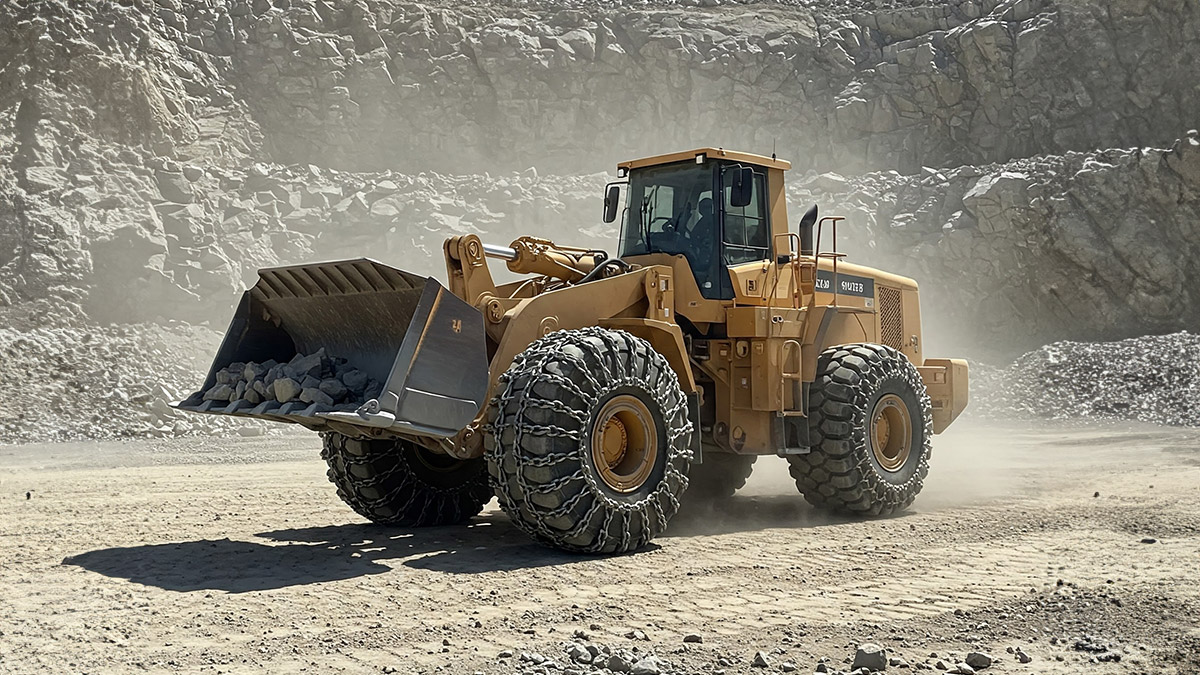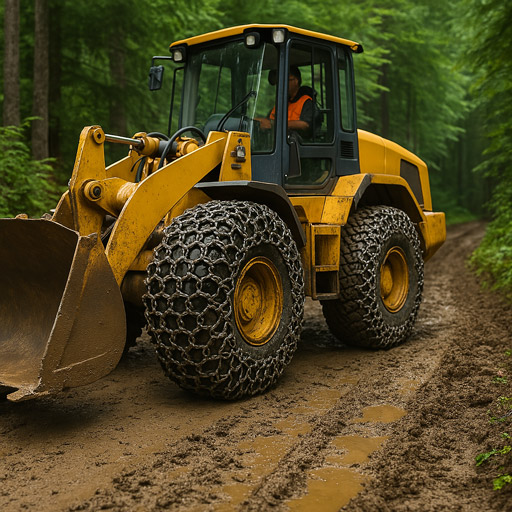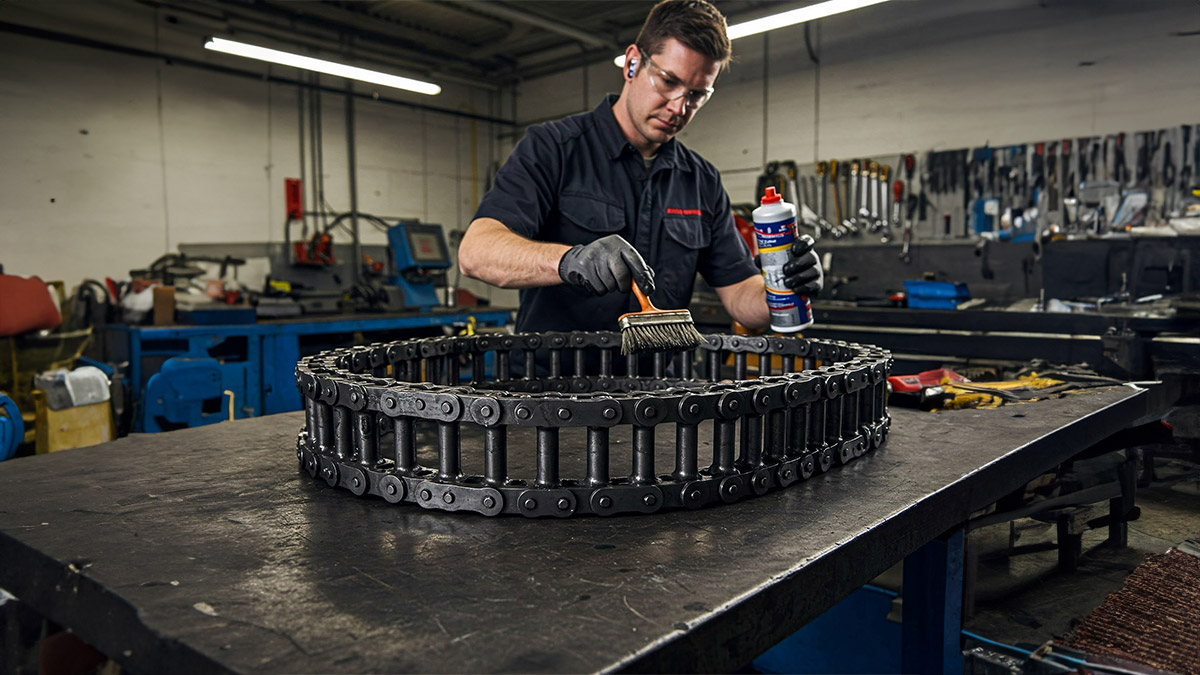The use of tire protection chains in heavy-duty machinery is critical for boosting performance and ensuring workplace safety. The material from which these chains are manufactured makes a significant difference in terms of lifespan and operational efficiency. Choosing the right material based on the intended use can reduce costs and support operational continuity. In this article, we’ll compare steel and alloy tire chains in terms of durability, cost, application areas, and safety.

What Are Tire Protection Chains and Why Are They Used?
Tire protection chains are essential equipment that help heavy-duty machinery operate safely and efficiently in harsh conditions. They protect against wear while directly impacting machine performance. Chain selection should consider the working environment and terrain conditions.
Main Functions of Tire Protection Chains
These chains not only protect tires from physical damage but also improve traction, reducing operational risks. They play a vital role in both safety and cost control.
Reducing Wear and Extending Tire Life
Tire protection chains safeguard tires from abrasive ground elements like sharp rocks, mining debris, and metal fragments. By reducing these impacts, the chains extend tire life, support operational continuity, and prevent downtime from unexpected tire replacements.
Enhancing Operational Safety
Chains improve ground grip, reducing the risk of slippage. Especially on sloped or muddy terrain, tire protection chains are vital for both operator and environmental safety. They prevent loss of control, ensuring machine stability and minimizing workplace accidents.
In Which Sectors Are They Used?
Choosing the right material and structure based on the sector significantly enhances efficiency and equipment life.
Mining and Quarrying
One of the most common areas of use is underground and open-pit mining. Steel tire protection chains offer extra resistance to impact and sharp surfaces, making them ideal for such high-risk environments.
Construction and Infrastructure Projects
Construction machinery must operate on various terrain types. Chains enhance traction, prevent skidding on concrete or asphalt, and reduce downtime, contributing to safer and more efficient operations.
Forestry and Agriculture
In sectors where machines operate on soft, slippery surfaces, alloy tire protection chains are preferred for their flexibility and light weight. They are ideal for environments with constantly changing terrain, offering balance and agility.
Steel vs. Alloy Chains: Material Characteristics
Steel and alloy chains differ significantly in structure and performance, especially when exposed to varying operational conditions. Choosing the right material is critical for operational continuity and cost-efficiency.
Structural Features of Steel Chains
Steel chains offer high durability and hardness, making them suitable for machines under heavy load. They are resistant to high temperatures and sharp surfaces, ensuring long-term use.
Hardness and Wear Resistance
Steel tire protection chains provide excellent defense against sharp rocks. Their surface strength protects tires from direct impact, increasing both tire life and operational safety.
Impact Absorption
Due to their dense structure, steel chains absorb sudden impacts effectively. This improves machine stability and contributes indirectly to operator safety, especially in tough conditions like rockfalls.
Structural Features of Alloy Chains
Alloy tire protection chains are known for their lightness and flexibility. They generate less surface friction, offering better maneuverability and performance in soft or muddy terrain.
Flexibility and Lightweight Design
Alloy chains do not restrict machine movement and are especially advantageous in confined areas. Their lighter weight reduces fuel consumption and allows for easier installation. They are ideal for short-term or seasonal operations.
Corrosion Resistance
Alloy chains generally offer better corrosion resistance. In humid or chemically exposed environments, they outperform steel chains in longevity and reduce maintenance frequency.
Performance Comparison Based on Application
The performance of chain types varies greatly depending on their application environment. Selection should factor in terrain, machine type, and operational intensity.
Effectiveness by Terrain Type
Steel and alloy chains perform differently depending on the ground they are used on. Choosing the right type improves traction and reduces tire wear.
Rocky and Metal-Rich Grounds
Steel chains perform best on hard, abrasive surfaces. Their high hardness provides resistance to impact and longevity, making them ideal for mining and quarry operations.
Muddy and Soft Grounds
Alloy chains offer better traction in mud and soft terrain. They don’t dig into the ground, making them suitable for agriculture. Their flexibility reduces slipping and improves control.
Suitability by Machine Type
Different machines have unique weight and movement dynamics, which influence the choice of chain.
Loaders and Excavators
For machines that handle heavy loads on rough terrain, steel chains provide better durability and lower replacement frequency. They are especially suited for open-field operations.
Underground Transport Vehicles
In tight and low-clearance areas, alloy chains offer better maneuverability and smoother operation. They also produce less noise than steel chains.

Cost and Long-Term Investment Analysis
Initial price isn’t the only factor; long-term durability and maintenance costs should also be considered. Steel and alloy chains represent different investment profiles.
Initial Purchase Costs
While steel chains typically cost more upfront, their longer life and resistance to wear may lead to lower total ownership cost over time.
Steel Chain Cost
Steel chains require higher initial investment but can last longer under tough conditions. Their reduced need for frequent replacement lowers both downtime and maintenance costs, making them ideal for machines with intense usage.
Alloy Chain Cost
Alloy chains are more affordable initially, making them a good option for short-term or seasonal use. However, they may need more frequent replacement, increasing long-term costs if not properly maintained.
Maintenance and Repair Considerations
Maintenance frequency and repair needs depend largely on material type. These affect the overall cost and operational efficiency of the chain.
Rusting and Breakage Risks
Steel chains are more prone to rust and require regular cleaning and lubrication. Alloy tire protection chains offer better resistance to corrosion but are more susceptible to breakage under heavy load, requiring frequent inspections.
Service Life and Recyclability
Both chain types are made from recyclable materials. However, steel chains can often be repurposed after their initial service life. With proper use and care, their lifespan can double, reducing long-term expenses.
Safety and Operational Advantages
Preventing workplace accidents and ensuring continuous operations are direct benefits of selecting the right chain. Machine control and workplace safety are highly dependent on chain quality.
How Chain Selection Impacts Safety
Chains don’t just protect tires; they also improve machine grip, which supports a safe work environment in the long run.
Reducing Slip Risks
Tire protection chains enhance traction on slippery surfaces, reducing slip and skid risks. This is especially critical in mines and sloped terrain, improving both operator and nearby personnel safety.
Braking and Maneuverability
Alloy chains enable smoother braking and direction changes due to their lighter build. This is important in restricted workspaces where responsive control is needed.
Role in Ensuring Operational Continuity
Continuous operations depend not just on machines but on durable equipment. Chains provide added protection that helps avoid unexpected failures.
Reducing Downtime
Tire protection chains help prevent blowouts and surface cracks, which are major causes of unexpected downtime. Fewer interruptions mean higher productivity and more consistent project timelines.
Optimizing Maintenance Intervals
Using the right chain extends tire maintenance intervals, reducing labor and service costs. It also contributes to a safer, more comfortable work environment for operators.

Choosing the Right Chain for the Job
When choosing between steel and alloy chains, consider not only price but also field conditions, machine type, and project duration. Selecting the most efficient option improves overall business performance.
Comparison Summary
Each chain type offers unique benefits. Durability, weight, cost, and area of use are key factors when comparing. Steel chains excel in long-term, harsh environments, while alloy chains suit short-term, confined operations.
Durability – Weight – Cost – Application
Steel chains are favored for their long service life and durability, while alloy chains offer flexibility and lightness. The choice depends on terrain and machine workload.
Expert Advice and Selection Tips
There’s no one-size-fits-all solution. However, with proper analysis, the most efficient and economical result can be achieved.
Considering Site Conditions
Before selecting a chain, evaluate site topography, climate, and ground structure. This ensures tire protection chains perform optimally and prevents unnecessary expenses.
Suitability to Machine and Load Type
For heavy-load machines, durability is key—steel chains are preferred. For agile, frequently maneuvering machines, alloy chains are more suitable. Matching the chain type to the machine prolongs lifespan and improves operational safety.


